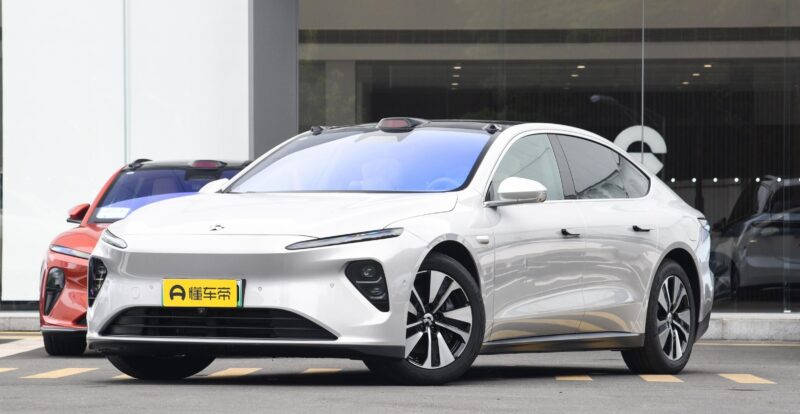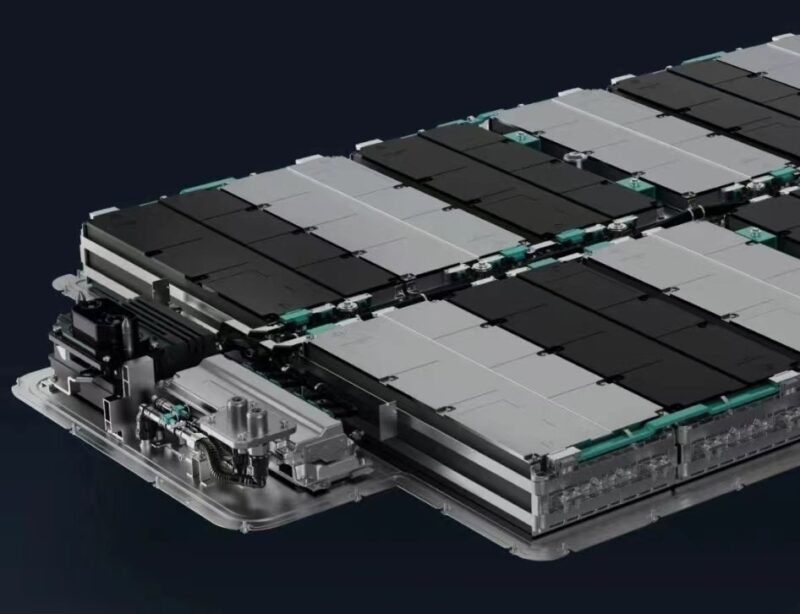Nio ET7 with 150 kWh semi-solid state battery achieves a 1,044 km range
William Li, Nio’s co-founder and CEO, personally tested the new 150 kWh semi-solid state battery (SSB). While driving the Nio ET7 large sedan, Li and his co-driver reached a 1,044 km (650 miles) range with 3% battery capacity remaining. That would most likely provide an additional 30 km range.
The 14-hour trip was live-streamed online, starting on Sunday morning at 6:32 am at the battery swap station (PSS) in Shanghai. Li’s first co-pilot was Shen Fei, Director of Nio Power. During the journey, William revealed that the 150 kWh battery had already been tested on a route between Kunming and Beihai, setting a record for mass-produced electric vehicles traveling 1,145 kilometers (711 miles).

92% of the time (957 km/ 595 miles), the ET7 was driving under the Navigate-on-Pilot+ (NOP+), Nio’s autonomous driving system. The maximum speed was caped to 90 km/hour (56 miles/hour), and the energy consumption was 13.2 kWh/100 km. The average speed for the trip was 83.9 km/h. The travel time was 12.4 hours, excluding stops and breaks, and 14 hours total.
Beijing-based battery maker WeLion New Energy Technology developed the 150 kWh SSB. It was announced three years ago at Nio Day 2020 (held in January 2021) when Nio’s first sedan, ET7, was launched.
The single cell has an energy density of 360 Wh/kg, while the whole pack has a 260 Wh/kg density. Nio claims the battery has a super cooling efficiency as the cooling is six times stronger than ordinary batteries.

Nio currently offers 75 kWh and 100 kWh NMC battery options for its vehicles, which have standard liquid electrolytes. Although the capacity of the new SSB is much bigger, it has the exact dimensions as the other two smaller packs and can be swapped into any Nio vehicle. Nio also announced that NT1 and NT2 platform-based vehicles are tested and certified to use the new battery.
The whole 150 kWh pack weighs 575 kg (1,268 lbs), only 20 kg more than the current Nio’s 100 kWh pack, which weighs 555kg. The dimensions are 2062/1539/186 mm (length/width/height), the same as all other Nio batteries. The Nio ET7 curb weight is 2,490 kg (5,490 lbs).
In theory, William Li could swap the battery when running out of power and receive another 1,000 km of range in three minutes. However, after a 14-hour trip, Li was most likely looking forward to a rest rather than driving back to Shanghai immediately.
“William, you better prepare an extra large cup of coffee, as this is going to be the longest EV range live stream ever,” posted Xpeng founder and CEO He Xiaopneg on this social network to support his frenemy.
When the testing was about in half, and Li passed the 500 km milestone, he called He Xiopeng, suggesting he should do a live stream about how X9 (Xpeng’s upcoming MPV) will sell well and if he could get a discount on the vehicle. He answered he would give him 50% off, but Li declined: “That’s too much, I have to leave you some margins.”

The temperature during the test was between -2 °C and 12 °C (28 – 54 °F). The coldest time was at the beginning of the test, as it was early morning in Shanghai. The average cabin temperature was 20 °C (68 °F). The carload was about 190 kg (two adults, lifestream equipment, and other items). The altitude difference between the start and end points was about -5 meters. The starting altitude was 18 m, and the ending was 23 m. The maximum altitude during the trip was 316 meters. The trip started in Shanghai and ended near Xiamen at the Longjudong Service Area.

The 150 kWh WeLion SSB will be very expensive. Nio President Qin Lihong revealed that the cost of the 150kWh battery pack will be equivalent to an ET5. ET5 75 kWh is priced at 298,000 yuan (42,100 USD).
In China, you can buy a Nio car without a battery. You subscribe to BaaS (Battery as a Service) and pay a monthly subscription fee. The battery stays on Nio’s balance sheet. In this case, you can upgrade the battery on demand. If you subscribe to a 75 kWh battery, you can upgrade to a 100 kWh battery for 50 yuan (7 USD) a day or 880 yuan (123 USD) a month. This would make 150 kWh an excellent option for a short upgrade when going on a long trip rather than being “a daily driver.”
Nio will hold a Nio Day 2023 on December 23 in Xi’an, unveiling a new Mercedes-Maybach-like ultra-luxurious sedan ET9, which will most likely be equipped with the new battery as a primary option.
According to Nio, the mass production of the new battery will start in April next year.



